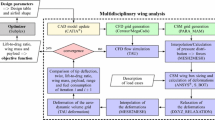Abstract
The paper presents the work related to the engine integration of a Rear Fuselage Mounted Engine configuration in the frame of the DLR/Onera project MDOrmec (“Multi-Disciplinary Optimisation of Rear-fuselage Mounted Engine Configuration”). The developed multidisciplinary optimisation process is based on a mixed-fidelity approach, where the aerodynamics is simulated using CFD methods while the weight, aircraft stability and control are assessed using preliminary design approach. The Breguet mission range is used as the objective value in order to find the best compromise between the aerodynamic performance of the aircraft and its structural weight. The stability and control qualities of the aircraft are also considered in order to ensure similar flight properties as the jet airliner Dornier Do-728, used as reference configuration. The engine-fuselage distance, the longitudinal and the circumferential engine position are used as the design parameters. Since the displacement of the engine impacts the centre of gravity of the aircraft, the longitudinal position of the wing is additionally used as parameter to provide similar longitudinal stability as the reference configuration. In order to ensure the control requirements, the tail planes are automatically sized during the process. The drag coefficient at required lift and zero pitching moment of the full configuration are obtained by using Euler computations at cruise conditions and adapting automatically the angle of attack and angle of incidence of the tail planes. The static margin of the aircraft is also evaluated using Euler computation. The resulting process chain is implemented in the ModelCenter optimisation framework. Finally, the results of the optimisation are presented and discussed in detail.





Similar content being viewed by others
Abbreviations
- a/c:
-
Aircraft
- c:
-
Speed of sound
- cMAC :
-
Main cord length
- CM :
-
Pitching moment coefficient
- m:
-
Mass
- MTOW:
-
Maximum take-off weight
- R:
-
Range
- S:
-
Area
- SM:
-
Static margin
- V:
-
Speed
- W:
-
Weight
- a/c:
-
Aircraft
- C:
-
Control
- D:
-
Drag
- E:
-
Engine
- H:
-
Horizontal tail plane
- S:
-
Stability
- TO:
-
Take-off
- V:
-
Vertical tail plane
- W:
-
Wing
References
Rossow, C.-C., Godard, J.-L., Hoheisel, H.: Investigation of propulsion integration interference effects on a transport aircraft configuration. AIAA. J. Aircraft 31(5), 1022–1030 (1994)
Brodersen, O., Taupin, K., Maury, E., Spieweg, R., Lieser, J., Laban, M., Godard, J.-L., Vitagliano, P.L., und Bigot, P.: Aerodynamic investigations in the European project ROSAS, 23rd AIAA Applied aerodynamics conference, Toronto (can), 6–9 June 2005
Raymer, D.P.: Aircraft design: a conceptual approach, ISBN 0-930403-51-7 (1989)
Schlichting, H., Truckenbrodt, E.: Aerodynamik des Flugzeuges, 3. Aufl., zweiter Band, ISBN 3-540-67375-X (2001)
http://www.phoenix-int.com/software/phx_modelcenter.php (2010)
Liersch, C.M., Hepperle, M.: A unated approach for multidisciplinary preliminary aircraft design, CEAS European air and space conference. Manchester, United Kingdom (2009)
http://www.centaur-soft.com (2010)
Schwamborn, D., Gerhold, T., Heinrich, R.: The DLR TAU-Code: Recent applications in research and industry, In proceedings of European conference on computational fluid dynamics ECCOMAS CDF 2006. Delft, The Netherlands (2006)
HAW Hamburg, Skript zur Vorlesung Flugzeugentwurf, Prof. Dr.-Ing. D. Scholz (1999)
Torenbeek, E.: Synthesis of subsonic airplane design, ISBN 90-298-2505-7 (1976)
Hader, C.: Datenanalyse Fairchild Dornier 728 MDORMEC, DLR Institute of Aerodynamics and Flow Technology (2007)
Werner-Westphal, C., Heinze, W., Horst, P.: Multidisciplinary integrated preliminary design applied to unconventional aircraft configuration. AIAA J. Aircraft 45(2), 581–590 (2008)
Grote, K.-H., Feldhusen, J.: Dubbel—Taschenbuch für Maschinenbau, 21. Auflage, ISBN 3-540-22142-2 (2005)
Documentation of the Phoenix Integration software: ModelCenter
Owen, A.B.: Othogonal arrays for computer experiments, integration and visualization. Statistica Sinica 2, 439–452 (1992)
Booker, A.J.: Design and analysis of computer experiments, 7th AIAA/USAF/NASA/ISSMO symposium on multidisciplinary analysis and optimization, St. Louis, MO (Sept. 2–4, 1998), pp. 118–128. AIAA-98-4757
Acknowledgments
The authors would like to thank Josef Natterer for his support by the pylon mass prediction module development.
Author information
Authors and Affiliations
Corresponding author
Rights and permissions
About this article
Cite this article
Haar, D., Brezillon, J. Engine integration based on multi-disciplinary optimisation technique. CEAS Aeronaut J 3, 17–24 (2012). https://doi.org/10.1007/s13272-011-0013-9
Received:
Revised:
Accepted:
Published:
Issue Date:
DOI: https://doi.org/10.1007/s13272-011-0013-9




